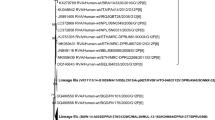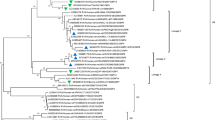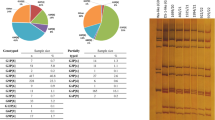Abstract
Reassortant DS-1-like rotavirus A strains have been shown to circulate widely in many countries around the world. In Russia, the prevalence of such strains remains unclear due to the preferred use of the traditional binary classification system. In this work, we obtained partial sequence data from all 11 genome segments and determined the full-genotype constellations of rare and reassortant rotaviruses circulating in Nizhny Novgorod in 2016–2019. DS-1-like G3P[8] and G8P[8] strains were found, reflecting the global trend. Most likely, these strains were introduced into the territory of Russia from other countries but subsequently underwent further evolutionary changes locally. G3P[8], G9P[8], and G12P[8] Wa-like strains of subgenotypic lineages that are unusual for the territory of Russia were also identified. Reassortant G2P[8], G4P[4], and G9P[4] strains with one Wa-like gene (VP4 or VP7) on a DS-1-like backbone were found, and these apparently had a local origin. Feline-like G3P[9] and G6P[9] strains were found to be phylogenetically close to BA222 isolated from a cat in Italy but carried some traces of reassortment with human strains from Russia and other countries. Thus, full-genotype determination of rotavirus A strains in Nizhny Novgorod has clarified some questions related to their origin and evolution.


Similar content being viewed by others
References
Troeger C, Khalil IA, Rao PC et al (2018) Rotavirus vaccination and the global burden of rotavirus diarrhea among children younger than 5 years. JAMA Pediatr 172:958. https://doi.org/10.1001/jamapediatrics.2018.1960
Burnett E, Parashar UD, Tate JE (2020) Real-world effectiveness of rotavirus vaccines, 2006–19: A literature review and meta-analysis. Lancet Glob Heal 8:e1195–e1202. https://doi.org/10.1016/S2214-109X(20)30262-X
Steele AD, Victor JC, Carey ME et al (2019) Experiences with rotavirus vaccines: Can we improve rotavirus vaccine impact in developing countries? Hum Vaccin Immunother 15:1215–1227. https://doi.org/10.1080/21645515.2018.1553593
Hallowell BD, Chavers T, Parashar U, Tate JE (2022) Global estimates of rotavirus hospitalizations among children below 5 years in 2019 and current and projected impacts of rotavirus vaccination. J Pediatr Infect Dis Soc 11:149–158. https://doi.org/10.1093/jpids/piab114
Namazova-Baranova LS, Fedoseenko MV, Kalyuzhnaia TA et al (2022) New possibilities of preventive immunization for rotavirus infection in Russian Federation. Overview of the innovative rotavirus vaccine profile. Pediatr Pharmacol 19(6):492–502. https://doi.org/10.15690/pf.v19i6.2489(Article in Russian)
Grinchik PR, Namazova-Baranova LS, Fedoseenko MV et al (2022) Comparative analysis of immunization and immunization coverage in children of Russian Federation federal districts. Pediatr Pharmacol 19:6–19. https://doi.org/10.15690/pf.v18i6.2351(Article in Russian)
Estes MK, Greenberg HB (2013) Rotaviruses. In: Knipe DM, Howley PM (eds) Fields Virology, 6th edn. Wolters Kluwer Health/Lippincott Williams & Wilkins, Philadelphia, pp 1347–1401
Matthijnssens J, Ciarlet M, Rahman M et al (2008) Recommendations for the classification of group A rotaviruses using all 11 genomic RNA segments. Arch Virol 153:1621–1629. https://doi.org/10.1007/s00705-008-0155-1
Matthijnssens J, Ciarlet M, Heiman E et al (2008) Full genome-based classification of rotaviruses reveals a common origin between human Wa-like and porcine rotavirus strains and human DS-1-like and bovine rotavirus strains. J Virol 82:3204–3219. https://doi.org/10.1128/JVI.02257-07
Heiman EM, McDonald SM, Barro M et al (2008) Group A human rotavirus genomics: Evidence that gene constellations are influenced by viral protein interactions. J Virol 82:11106–11116. https://doi.org/10.1128/JVI.01402-08
Nakagomi T, Nakagomi O (1989) RNA-RNA hybridization identifies a human rotavirus that is genetically related to feline rotavirus. J Virol 63:1431–1434. https://doi.org/10.1128/jvi.63.3.1431-1434.1989
Tsugawa T, Rainwater-Lovett K, Tsutsumi H (2015) Human G3P[9] rotavirus strains possessing an identical genotype constellation to AU-1 isolated at high prevalence in Brazil, 1997–1999. J Gen Virol 96:590–600. https://doi.org/10.1099/vir.0.071373-0
Matthijnssens J, De Grazia S, Piessens J et al (2011) Multiple reassortment and interspecies transmission events contribute to the diversity of feline, canine and feline/canine-like human group A rotavirus strains. Infect Genet Evol 11:1396–1406. https://doi.org/10.1016/j.meegid.2011.05.007
McDonald SM, McKell AO, Rippinger CM et al (2012) Diversity and relationships of cocirculating modern human rotaviruses revealed using large-scale comparative genomics. J Virol 86:9148–9162. https://doi.org/10.1128/JVI.01105-12
Zhang S, McDonald PW, Thompson TA et al (2014) Analysis of human rotaviruses from a single location over an 18-year time span suggests that protein coadaption influences gene constellations. J Virol 88:9842–9863. https://doi.org/10.1128/JVI.01562-14
Dóró R, Mihalov-Kovács E, Marton S et al (2014) Large-scale whole genome sequencing identifies country-wide spread of an emerging G9P[8] rotavirus strain in Hungary, 2012. Infect Genet Evol 28:495–512. https://doi.org/10.1016/j.meegid.2014.09.016
Dian Z, Wang B, Fan M et al (2017) Completely genomic and evolutionary characteristics of humandominant G9P[8] group A rotavirus strains in Yunnan, China. J Gen Virol 98:1163–1168. https://doi.org/10.1099/jgv.0.000807
Santos FS, Sousa Junior EC, Guerra SFS et al (2019) G1P[8] Rotavirus in children with severe diarrhea in the post-vaccine introduction era in Brazil: Evidence of reassortments and structural modifications of the antigenic VP7 and VP4 regions. Infect Genet Evol 69:255–266. https://doi.org/10.1016/j.meegid.2019.02.009
Yamamoto SP, Kaida A, Kubo H, Iritani N (2014) Gastroenteritis outbreaks caused by a DS-1-like G1P[8] Rotavirus strain, Japan, 2012–2013. Emerg Infect Dis 20:1030–1033. https://doi.org/10.3201/eid2006.131326
Hoa-Tran TN, Nakagomi T, Vu HM et al (2016) Abrupt emergence and predominance in Vietnam of rotavirus A strains possessing a bovine-like G8 on a DS-1-like background. Arch Virol 161:479–482. https://doi.org/10.1007/s00705-015-2682-x
Hoa-Tran TN, Nakagomi T, Vu HM et al (2020) Detection of three independently-generated DS-1-like G9P[8] reassortant rotavirus A strains during the G9P[8] dominance in Vietnam, 2016–2018. Infect Genet Evol 80:104194. https://doi.org/10.1016/j.meegid.2020.104194
Cowley D, Donato CM, Roczo-Farkas S, Kirkwood CD (2016) Emergence of a novel equine-like G3P[8] inter-genogroup reassortant rotavirus strain associated with gastroenteritis in Australian children. J Gen Virol 97:403–410. https://doi.org/10.1099/jgv.0.000352
Sashina TA, Morozova OV, Epifanova NV, Novikova NA (2020) Genotype constellations of the rotavirus A strains circulating in Nizhny Novgorod, Russia, 2017–2018. Infect Genet Evol 85:104578. https://doi.org/10.1016/j.meegid.2020.104578
Morozova OV, Sashina TA, Novikova NA (2017) Detection and molecular characterization of reassortant DS-1-like G1P [8] strains of rotavirus A. Probl Virol 62:91–96. https://doi.org/10.18821/0507-4088-2017-62-2-91-96(Article in Russian)
Petrusha OA, Korchevaya ER, Mintaev RR et al (2022) Molecular and genetic characteristics of group A rotaviruses detected in Moscow in 2015–2020. J Microbiol Epidemiol Immunobiol 99(1):7–19. https://doi.org/10.36233/0372-9311-208(Article in Russian)
Novikova NA, Sashina TA, Epifanova NV et al (2020) Long-term monitoring of G1P[8] rotaviruses circulating without vaccine pressure in Nizhny Novgorod, Russia, 1984–2019. Arch Virol 165:865–875. https://doi.org/10.1007/s00705-020-04553-2
Sashina TA, Morozova OV, Epifanova NV, Novikova NA (2019) Identification of rotavirus I- and E-genotypes by multiplex PCR method. Probl Virol 64:140–144. https://doi.org/10.18821/0507-4088-2019-64-3-140-144(Article in Russian)
Bok K, Matson DO, Gomez JA (2002) Genetic variation of capsid protein VP7 in genotype G4 human rotavirus strains: Simultaneous emergence and spread of different lineages in Argentina. J Clin Microbiol 40:2016–2022. https://doi.org/10.1128/JCM.40.6.2016-2022.2002
Phan TG, Khamrin P, Quang TD et al (2007) Detection and Genetic Characterization of group A rotavirus strains circulating among children with acute gastroenteritis in Japan. J Virol 81:4645–4653. https://doi.org/10.1128/JVI.02342-06
Phan TG, Okitsu S, Maneekarn N, Ushijima H (2007) Genetic heterogeneity, evolution and recombination in emerging G9 rotaviruses. Infect Genet Evol 7:656–663. https://doi.org/10.1016/j.meegid.2007.05.001
da Silva MFM, Gómez MM, Rose TL et al (2013) VP8∗P[8] lineages of group A rotaviruses circulating over 20 years in Brazil: Proposal of six different sub-lineages for P[8]-3 clade. Infect Genet Evol 16:200–205. https://doi.org/10.1016/J.MEEGID.2013.01.004
Giammanco GM, Bonura F, Zeller M et al (2014) Evolution of DS-1-like human G2P[4] rotaviruses assessed by complete genome analyses. J Gen Virol 95:91–109. https://doi.org/10.1099/vir.0.056788-0
Doan YH, Nakagomi T, Agbemabiese CA, Nakagomi O (2015) Changes in the distribution of lineage constellations of G2P[4] Rotavirus A strains detected in Japan over 32 years (1980–2011). Infect Genet Evol 34:423–433. https://doi.org/10.1016/J.MEEGID.2015.05.026
Pradhan GN, Chitambar SD (2018) Full genomic analysis of G1P[8] rotavirus strains recovered from rotavirus vaccinated and non-vaccinated children hospitalized for acute gastroenteritis in Pune, western India. J Med Virol 90:772–778. https://doi.org/10.1002/jmv.25007
Agbemabiese CA, Nakagomi T, Damanka SA et al (2019) Sub-genotype phylogeny of the non-G, non-P genes of genotype 2 Rotavirus A strains. PLoS ONE 14:e0217422. https://doi.org/10.1371/journal.pone.0217422
Komoto S, Ide T, Negoro M et al (2018) Characterization of unusual DS-1-like G3P[8] rotavirus strains in children with diarrhea in Japan. J Med Virol 90:890–898. https://doi.org/10.1002/jmv.25016
Komoto S, Tacharoenmuang R, Guntapong R et al (2016) Reassortment of human and animal rotavirus gene segments in emerging DS-1-like G1P[8] rotavirus strains. PLoS ONE 11:e0148416. https://doi.org/10.1371/journal.pone.0148416
Tacharoenmuang R, Komoto S, Guntapong R et al (2016) Full genome characterization of novel DS-1-like G8P[8] rotavirus strains that have emerged in Thailand: Reassortment of bovine and human rotavirus gene segments in emerging DS-1-like intergenogroup reassortant strains. PLoS ONE 11:e0165826. https://doi.org/10.1371/journal.pone.0165826
Arana A, Montes M, Jere KC et al (2016) Emergence and spread of G3P[8] rotaviruses possessing an equine-like VP7 and a DS-1-like genetic backbone in the Basque Country (North of Spain), 2015. Infect Genet Evol 44:137–144. https://doi.org/10.1016/j.meegid.2016.06.048
Kamiya H, Tacharoenmuang R, Ide T et al (2019) Characterization of an unusual DS-1-like G8P[8] rotavirus strain from Japan in 2017: Evolution of emerging DS-1-like G8P[8] strains through reassortment. Jpn J Infect Dis 72:256–260. https://doi.org/10.7883/yoken.JJID.2018.484
Kumar S, Stecher G, Li M et al (2018) MEGA X: molecular evolutionary genetics analysis across computing platforms. Mol Biol Evol 35:1547–1549. https://doi.org/10.1093/molbev/msy096
Drummond AJ, Suchard MA, Xie D, Rambaut A (2012) Bayesian phylogenetics with BEAUti and the BEAST 1.7. Mol Biol Evol 29:1969–1973. https://doi.org/10.1093/molbev/mss075
Novikova NA, Morozova OV, Fedorova OF et al (2012) Rotavirus infection in children of Nizhny Novgorod, Russia: The gradual change of the virus allele from P[8]-1 to P[8]-3 in the period 1984–2010. Arch Virol 157:2405–2409. https://doi.org/10.1007/s00705-012-1426-4
Sashina TA, Morozova OV, Epifanova NV, Novikova NA (2017) Predominance of new G9P[8] rotaviruses closely related to Turkish strains in Nizhny Novgorod (Russia). Arch Virol 162:2387–2392. https://doi.org/10.1007/s00705-017-3364-7
Morozova OV, Sashina TA, Epifanova NV et al (2021) Increasing detection of rotavirus G2P[4] strains in Nizhny Novgorod, Russia, between 2016 and 2019. Arch Virol 166:115–124. https://doi.org/10.1007/s00705-020-04853-7
Sashina TA, Morozova OV, Epifanova NV et al (2021) Molecular monitoring of the rotavirus (Reoviridae: Sedoreovirinae: Rotavirus: Rotavirus A) strains circulating in Nizhny Novgorod (2012–2020): Detection of the strains with the new genetic features. Probl Virol 66:140–151. https://doi.org/10.36233/0507-4088-46(Article in Russian)
Morozova OV, Alekseeva AE, Sashina TA et al (2020) Phylodynamics of G4P[8] and G2P[4] strains of rotavirus A isolated in Russia in 2017 based on full-genome analyses. Virus Genes 56:537–545. https://doi.org/10.1007/s11262-020-01771-3
Lu Y, Li H, Li W et al (2020) Characterization of a G9 group A rotavirus reassortant strain detected in Jinzhou, China, in 2018–2019. Arch Virol 165:977–983. https://doi.org/10.1007/s00705-020-04563-0
Phan T, Ide T, Komoto S et al (2020) Unusual mono-reassortant of a Wa-like G1P[8] species A rotavirus containing a DS-1-like (genotype 2) NSP4 gene. Virus Genes 56:638–641. https://doi.org/10.1007/s11262-020-01780-2
Fujii Y, Oda M, Somura Y, Shinkai T (2020) Molecular characteristics of novel mono-reassortant G9P[8] rotavirus a strains possessing the NSP4 gene of the E2 genotype detected in Tokyo, Japan. Jpn J Infect Dis 73:26–35. https://doi.org/10.7883/yoken.JJID.2019.211
Fukuda S, Akari Y, Hatazawa R et al (2022) Rapid spread in Japan of unusual G9P[8] human rotavirus strains possessing NSP4 genes of E2 genotype. Jpn J Infect Dis 75. https://doi.org/10.7883/yoken.JJID.2022.020. :JJID.2022.020
Moutelíková R, Sauer P, Prodělalová J (2020) Whole-genome sequence of a reassortant G9P[4] rotavirus A strain from two children in the Czech Republic. Arch Virol 165:1703–1706. https://doi.org/10.1007/s00705-020-04648-w
Zeng Y, Zhao B, Li T et al (2020) Molecular characterization of an uncommon multigene Reassortant G1P[4] rotavirus identified in China. Infect Genet Evol 85:104413. https://doi.org/10.1016/j.meegid.2020.104413
Maringa WM, Simwaka J, Mwangi PN et al (2021) Whole genome analysis of human rotaviruses reveals single gene reassortant rotavirus strains in Zambia. Viruses 13:1872. https://doi.org/10.3390/v13091872
Rasebotsa S, Uwimana J, Mogotsi MT et al (2021) Whole-genome analyses identifies multiple reassortant rotavirus strains in Rwanda post-vaccine introduction. Viruses 13:1–15. https://doi.org/10.3390/v13010095
Jere KC, Chaguza C, Bar-Zeev N et al (2018) Emergence of double- and triple-gene reassortant G1P[8] rotaviruses possessing a DS-1-like backbone after rotavirus vaccine introduction in Malawi. J Virol 92(3):e01246–e01217. https://doi.org/10.1128/JVI.01246-17
Perkins C, Mijatovic-Rustempasic S, Ward ML et al (2017) Genomic characterization of the first equine-like G3P[8] rotavirus strain detected in the United States. Genome Announc 47:e01341–e01317. https://doi.org/10.1128/genomeA.01341-17
Pietsch C, Liebert UG (2018) Molecular characterization of different equine-like G3 rotavirus strains from Germany. Infect Genet Evol 57:46–50. https://doi.org/10.1016/j.meegid.2017.11.007
Kikuchi W, Nakagomi T, Gauchan P et al (2018) Detection in Japan of an equine-like G3P[8] reassortant rotavirus A strain that is highly homologous to European strains across all genome segments. Arch Virol 163:791–794. https://doi.org/10.1007/s00705-017-3668-7
Luchs A, Da Costa AC, Cilli A et al (2019) Spread of the emerging equine-like G3P[8] DS-1-like genetic backbone rotavirus strain in Brazil and identification of potential genetic variants. J Gen Virol 100:7–25. https://doi.org/10.1099/jgv.0.001171
Guerra SFS, Soares LS, Lobo PS et al (2016) Detection of a novel equine-like G3 rotavirus associated with acute gastroenteritis in Brazil. J Gen Virol 97:3131–3138. https://doi.org/10.1099/jgv.0.000626
Dóró R, Marton S, Bartókné AH et al (2016) Equine-like G3 rotavirus in Hungary, 2015 - Is it a novel intergenogroup reassortant pandemic strain? Acta Microbiol Immunol Hung 63:243–255. https://doi.org/10.1556/030.63.2016.2.8
Hoa-Tran TN, Nakagomi T, Vu HM et al (2019) Whole genome characterization of feline-like G3P[8] reassortant rotavirus A strains bearing the DS-1-like backbone genes detected in Vietnam, 2016. Infect Genet Evol 73:1–6. https://doi.org/10.1016/j.meegid.2019.04.007
Esposito S, Camilloni B, Bianchini S et al (2019) First detection of a reassortant G3P[8] rotavirus A strain in Italy: A case report in an 8-year-old child. Virol J 16:64. https://doi.org/10.1186/s12985-019-1173-1
Moutelíková R, Sauer P, Dvořáková Heroldová M et al (2019) Emergence of rare bovine–human reassortant DS-1-like Rotavirus A strains with G8P[8] genotype in human patients in the Czech Republic. Viruses 11:1015. https://doi.org/10.3390/v11111015
Bonura F, Bányai K, Mangiaracina L et al (2022) Emergence in 2017–2019 of novel reassortant equine-like G3 rotavirus strains in Palermo, Sicily. Transbound Emerg Dis 69:813–835. https://doi.org/10.1111/tbed.14054
Utsumi T, Wahyuni RM, Doan YH et al (2018) Equine-like G3 rotavirus strains as predominant strains among children in Indonesia in 2015–2016. Infect Genet Evol 61:224–228. https://doi.org/10.1016/j.meegid.2018.03.027
Athiyyah AF, Utsumi T, Wahyuni RM et al (2019) Molecular epidemiology and clinical features of rotavirus infection among pediatric patients in East Java, Indonesia during 2015–2018: Dynamic changes in rotavirus genotypes from equine-like G3 to typical human G1/G3. Front Microbiol 10:940. https://doi.org/10.3389/fmicb.2019.00940
Tacharoenmuang R, Komoto S, Guntapong R et al (2020) High prevalence of equine-like G3P[8] rotavirus in children and adults with acute gastroenteritis in Thailand. J Med Virol 92:174–186. https://doi.org/10.1002/jmv.25591
Roczo-Farkas S, Bines JE (2021) Australian rotavirus surveillance program: Annual report, 2018. Commun Dis Intell 45. https://doi.org/10.33321/cdi.2021.45.6
Chia G, Ho HJ, Ng CG et al (2018) An unusual outbreak of rotavirus G8P[8] gastroenteritis in adults in an urban community, Singapore, 2016. J Clin Virol 105:57–63. https://doi.org/10.1016/j.jcv.2018.06.004
Kondo K, Tsugawa T, Ono M et al (2017) Clinical and molecular characteristics of human rotavirus G8P[8] outbreak strain, Japan, 2014. Emerg Infect Dis 23:968–972. https://doi.org/10.3201/eid2306.160038
Phan T, Kobayashi M, Nagasawa K et al (2022) Whole genome sequencing and evolutionary analysis of G8P[8] rotaviruses emerging in Japan. Virus Disease 33:215–218. https://doi.org/10.1007/s13337-022-00765-z
Mwangi PN, Mogotsi MT, Rasebotsa SP et al (2020) Uncovering the first atypical DS-1-like G1P[8] rotavirus strains that circulated during pre-rotavirus vaccine introduction era in South Africa. Pathogens 9(5):391. https://doi.org/10.3390/pathogens9050391
Martella V, Potgieter AC, Lorusso E et al (2011) A feline rotavirus G3P[9] carries traces of multiple reassortment events and resembles rare human G3P[9] rotaviruses. J Gen Virol 92:1214–1221. https://doi.org/10.1099/vir.0.027425-0
Fredj MBH, Heylen E, Zeller M et al (2013) Feline origin of rotavirus strain, Tunisia, 2008. Emerg Infect Dis 19:630–634. https://doi.org/10.3201/eid1904.121383
Jeong S, Than VT, Lim I, Kim W (2014) Whole-genome analysis of a rare human Korean G3P[9] rotavirus strain suggests a complex evolutionary origin potentially involving reassortment events between feline and bovine rotaviruses. PLoS ONE 9:1–8. https://doi.org/10.1371/journal.pone.0097127
Mladenova Z, Nawaz S, Ganesh B, Iturriza-Gomara M (2015) Increased detection of G3P[9] and G6P[9] rotavirus strains in hospitalized children with acute diarrhea in Bulgaria. Infect Genet Evol 29:118–126. https://doi.org/10.1016/j.meegid.2014.11.011
Mijatovic-Rustempasic S, Roy S, Sturgeon M et al (2014) Full-genome sequence of a rare human G3P[9] rotavirus strain. Genome Announc 2:9–10. https://doi.org/10.1128/genomeA.00143-14
Gauchan P, Sasaki E, Nakagomi T et al (2015) Whole genotype constellation of prototype feline rotavirus strains FRV-1 and FRV64 and their phylogenetic relationships with feline-like human rotavirus strains. J Gen Virol 96:338–350. https://doi.org/10.1099/vir.0.070771-0
Funding
This study was supported by the Russian Federal Service for Surveillance on Consumer Rights Protection and Human Wellbeing and by Russian Foundation for Basic Research (project no. 18-34-00586).
Author information
Authors and Affiliations
Contributions
TAS conceived and designed the experiments. TAS, EIV, OVM, and NVE performed the experiments. TAS and EIV analyzed the data. TAS and NAN wrote the manuscript. All authors revised and approved the final version of the manuscript.
Corresponding author
Ethics declarations
Conflict of interest
The authors have no relevant financial or non-financial interests to disclose.
Ethical approval
This study was approved by the Ethics Committee of the I.N. Blokhina Nizhny Novgorod Research Institute of Epidemiology and Microbiology of the Russian Federal Service for Surveillance on Consumer Rights Protection and Human Wellbeing. The patient identities were de-linked from their unique laboratory identifiers to ensure confidentiality.
Additional information
Communicated by Tim Skern
Publisher’s Note
Springer Nature remains neutral with regard to jurisdictional claims in published maps and institutional affiliations.
Electronic Supplementary Material
Below is the link to the electronic supplementary material
Rights and permissions
Springer Nature or its licensor (e.g. a society or other partner) holds exclusive rights to this article under a publishing agreement with the author(s) or other rightsholder(s); author self-archiving of the accepted manuscript version of this article is solely governed by the terms of such publishing agreement and applicable law.
About this article
Cite this article
Sashina, T.A., Velikzhanina, E.I., Morozova, O.V. et al. Detection and full-genotype determination of rare and reassortant rotavirus A strains in Nizhny Novgorod in the European part of Russia. Arch Virol 168, 215 (2023). https://doi.org/10.1007/s00705-023-05838-y
Received:
Accepted:
Published:
DOI: https://doi.org/10.1007/s00705-023-05838-y




